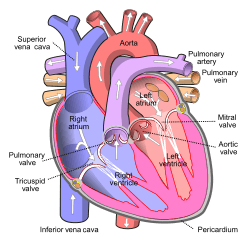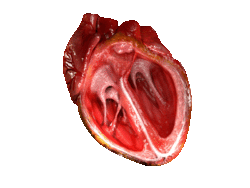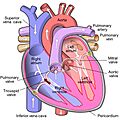Tricuspid valve facts for kids
Quick facts for kids Tricuspid valve |
|
|---|---|
 |
|
| A front view of the heart with the front wall removed. White arrows show the normal path of blood. The tricuspid valve is labeled at the bottom left. | |
 |
|
| A moving image of the heart. The tricuspid valve's action can be seen on the left side of this picture. | |
| Latin | valvula tricuspidalis, valva atrioventricularis dextra |
The tricuspid valve is one of the four main valves in the heart of mammals, including humans. Think of it as a one-way door on the right side of your heart. It sits between the heart's top-right chamber (the right atrium) and the bottom-right chamber (the right ventricle).
The valve's main job is to control the flow of blood. It opens to let blood move from the right atrium into the right ventricle. Then, it closes tightly to stop blood from flowing backward when the heart pumps.
Contents
What the Tricuspid Valve Looks Like
The tricuspid valve gets its name because it usually has three flaps of tissue. These flaps are also called leaflets or cusps. They are named the anterior, posterior, and septal cusps.
Each leaflet is connected to tiny, strong strings called chordae tendineae. These "heart strings" are like the strings on a parachute. They connect the leaflets to small muscles inside the right ventricle called papillary muscles. This clever design helps the valve open and close at just the right time, preventing it from flipping backward.
While most people have three leaflets, some can be born with two or four.
How the Tricuspid Valve Works
The tricuspid valve is a key player in making sure blood flows through the heart in the correct direction. It opens and closes with every heartbeat.
- When the heart relaxes (this phase is called diastole), the tricuspid valve opens. This allows blood that has returned from the body to flow from the right atrium and fill the right ventricle.
- When the heart pumps (this phase is called systole), the right ventricle squeezes to send blood to the lungs. At this moment, the tricuspid valve snaps shut. This prevents blood from leaking back into the right atrium.
This perfectly timed action ensures that the heart works efficiently as a pump.
Health Issues Affecting the Valve
Sometimes, the tricuspid valve can have problems that affect a person's health.
When the Valve Leaks (Regurgitation)
Tricuspid regurgitation is a condition where the valve doesn't close tightly. This allows some blood to leak, or flow backward, from the ventricle into the atrium.
A very tiny amount of leakage is actually very common and usually harmless. Studies have shown that up to 85% of healthy people have a small, trace amount of tricuspid regurgitation.
However, if the leak is moderate or severe, it can make the heart work much harder. Over a long time, this extra work can cause the right side of the heart to stretch and weaken, which may lead to more serious heart conditions.
Other Valve Conditions
- Infections: Sometimes, bacteria can enter the bloodstream and cause an infection on the heart valves. This is a serious condition called endocarditis. The bacteria Staphylococcus aureus is a common cause of infection that affects the tricuspid valve.
- Rheumatic Fever: This is an illness that can happen after a throat infection. Rheumatic fever can damage the heart valves, causing them to become narrow or leaky.
- Congenital Conditions: Some people are born with a tricuspid valve that did not form correctly. One example is Ebstein's anomaly, where the valve is in the wrong position and often leaks severely.
- Carcinoid Syndrome: This is a rare condition where certain tumors release chemicals into the body that can cause the valve leaflets to become stiff and thick, preventing them from working properly.
Fortunately, doctors have many ways to treat valve problems, including surgery to repair or replace a damaged valve. The first procedure to replace a tricuspid valve using a less invasive tube-based method was performed by surgeons at the Cleveland Clinic.
Additional images
See also
- Tricuspid atresia
- Cavo-tricuspid isthmus
- Lancisi's sign
- Right atrial enlargement




